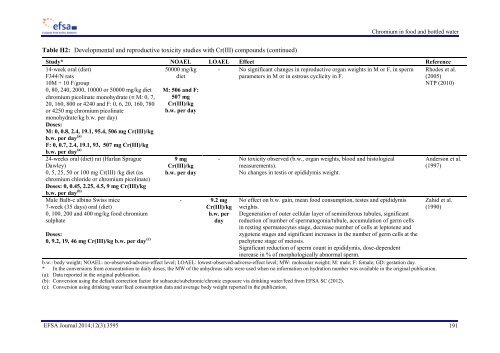efsa-opinion-chromium-food-drinking-water
efsa-opinion-chromium-food-drinking-water
efsa-opinion-chromium-food-drinking-water
Create successful ePaper yourself
Turn your PDF publications into a flip-book with our unique Google optimized e-Paper software.
Chromium in <strong>food</strong> and bottled <strong>water</strong><br />
Table H2: Developmental and reproductive toxicity studies with Cr(III) compounds (continued)<br />
Study* NOAEL LOAEL Effect Reference<br />
14-week oral (diet)<br />
F344/N rats<br />
10M + 10 F/group<br />
0, 80, 240, 2000, 10000 or 50000 mg/kg diet<br />
<strong>chromium</strong> picolinate monohydrate ( M: 0, 7,<br />
20, 160, 800 or 4240 and F: 0, 6, 20, 160, 780<br />
or 4250 mg <strong>chromium</strong> picolinate<br />
monohydrate/kg b.w. per day)<br />
Doses:<br />
M: 0, 0.8, 2.4, 19.1, 95.4, 506 mg Cr(III)/kg<br />
b.w. per day (a)<br />
F: 0, 0.7, 2.4, 19.1, 93, 507 mg Cr(III)/kg<br />
b.w. per day (a)<br />
50000 mg/kg<br />
diet<br />
M: 506 and F:<br />
507 mg<br />
Cr(III)/kg<br />
b.w. per day<br />
- No significant changes in reproductive organ weights in M or F, in sperm<br />
parameters in M or in estrous cyclicity in F.<br />
Rhodes et al.<br />
(2005)<br />
NTP (2010)<br />
24-weeks oral (diet) rat (Harlan Sprague<br />
Dawley)<br />
0, 5, 25, 50 or 100 mg Cr(III) /kg diet (as<br />
<strong>chromium</strong> chloride or <strong>chromium</strong> picolinate)<br />
Doses: 0, 0.45, 2.25, 4.5, 9 mg Cr(III)/kg<br />
b.w. per day (b)<br />
9 mg<br />
Cr(III)/kg<br />
b.w. per day<br />
Male Balb-c albino Swiss mice<br />
7-week (35 days) oral (diet)<br />
0, 100, 200 and 400 mg/kg <strong>food</strong> <strong>chromium</strong><br />
sulphate<br />
Doses:<br />
0, 9.2, 19, 46 mg Cr(III)/kg b.w. per day (c) - 9.2 mg<br />
Cr(III)/kg<br />
b.w. per<br />
day<br />
- No toxicity observed (b.w., organ weights, blood and histological<br />
measurements).<br />
No changes in testis or epididymis weight.<br />
No effect on b.w. gain, mean <strong>food</strong> consumption, testes and epididymis<br />
weights.<br />
Degeneration of outer cellular layer of seminiferous tubules, significant<br />
reduction of number of spermatogonia/tubule, accumulation of germ cells<br />
in resting spermatocytes stage, decrease number of cells at leptotene and<br />
zygotene stages and significant increases in the number of germ cells at the<br />
pachytene stage of meiosis.<br />
Significant reduction of sperm count in epididymis, dose-dependent<br />
increase in % of morphologically abnormal sperm.<br />
b.w.: body weight; NOAEL: no-observed-adverse-effect level; LOAEL: lowest-observed-adverse-effect level; MW: molecular weight; M: male; F: female; GD: gestation day.<br />
* In the conversions from concentration to daily doses, the MW of the anhydrous salts were used when no information on hydration number was available in the original publication.<br />
(a): Data reported in the original publication.<br />
(b): Conversion using the default correction factor for subacute/subchronic/chronic exposure via <strong>drinking</strong> <strong>water</strong>/feed from EFSA SC (2012).<br />
(c): Conversion using <strong>drinking</strong> <strong>water</strong>/feed consumption data and average body weight reported in the publication.<br />
Anderson et al.<br />
(1997)<br />
Zahid et al.<br />
(1990)<br />
EFSA Journal 2014;12(3):3595 191



